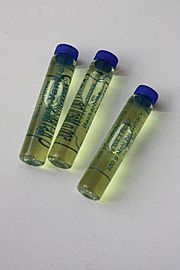Diacetyl facts for kids
Quick facts for kids Diacetyl |
|
|---|---|
 |
|
 |
|
|
Preferred IUPAC name
Butane-2,3-dione
|
|
| Other names | Diacetyl Biacetyl Dimethyl diketone 2,3-Diketobutane |
| Identifiers | |
| CAS number | |
| PubChem | |
| KEGG | C00741 |
| ChEBI | CHEBI:16583 |
| RTECS number | EK2625000 |
| SMILES | CC(=O)C(=O)C |
|
InChI
InChI=1/C4H6O2/c1-3(5)4(2)6/h1-2H3
|
|
| Beilstein Reference | 605398 |
| 3DMet | B00164 |
| Properties | |
| Molecular formula | C4H6O2 |
| Molar mass | 86.08 g mol-1 |
| Appearance | Yellow liquid |
| Density | 0.990 g/mL at 15 °C |
| Melting point |
−2 to −4 °C, Expression error: Unrecognized word "to". K, Expression error: Unrecognized word "to". °F |
| Boiling point |
88 °C, 361 K, 190 °F |
| Solubility in water | 200 g/L (20 °C) |
| Hazards | |
| Main hazards | Harmful, flammable |
| NFPA 704 |
|
| Except where noted otherwise, data are given for materials in their standard state (at 25 °C, 100 kPa) | |
Diacetyl (IUPAC systematic name: butanedione or butane-2,3-dione) is an organic compound with the chemical formula (CH3CO)2. It is a yellow liquid with an intensely buttery flavor. It is a vicinal diketone (two C=O groups, side-by-side). Diacetyl occurs naturally in alcoholic beverages and is added as a flavoring to some foods to impart its buttery flavor.
Contents
Chemical structure
A distinctive feature of diacetyl (and other vicinal diketones) is the long C–C bond linking the carbonyl centers. This bond distance is about 1.54 Å, compared to 1.45 Å for the corresponding C–C bond in 1,3-butadiene. The elongation is attributed to repulsion between the polarized carbonyl carbon centers.
Occurrence and biosynthesis
Diacetyl arises naturally as a byproduct of fermentation. In some fermentative bacteria, it is formed via the thiamine pyrophosphate-mediated condensation of pyruvate and acetyl CoA. Sour (cultured) cream, cultured buttermilk, and cultured butter are produced by inoculating pasteurized cream or milk with a lactic starter culture, churning (agitating) and holding the milk until a desired pH drop (or increase in acidity) is attained. Cultured cream, cultured butter, and cultured buttermilk owe their tart flavour to lactic acid bacteria and their buttery aroma and taste to diacetyl. Malic acid can be converted to lactic acid to make diacetyl.
Production
Diacetyl is produced industrially by dehydrogenation of 2,3-butanediol. Acetoin is an intermediate.
Applications
In food products
Diacetyl and acetoin are two compounds that give butter its characteristic taste. Because of this, manufacturers of artificial butter flavoring, margarines or similar oil-based products typically add diacetyl and acetoin (along with beta-carotene for the yellow color) to make the final product butter-flavored, because it would otherwise be relatively tasteless.
Electronic cigarettes
Diacetyl is used as a flavoring agent in some liquids used in electronic cigarettes. and people nearby may be exposed to it in the exhaled aerosol at levels near the limit set for occupational exposure.
In alcoholic beverages
In some styles of beer (e.g. in many beer styles produced in the United Kingdom, such as stouts, English bitters, and Scottish ales), the presence of diacetyl can be acceptable or desirable at low or, in some cases, moderate levels. In other styles, its presence is considered a flaw or undesirable.
Diacetyl is produced during fermentation as a byproduct of valine synthesis, when yeast produces α-acetolactate, which escapes the cell and is spontaneously decarboxylated into diacetyl. The yeast then absorbs the diacetyl, and reduces the ketone groups to form acetoin and 2,3-butanediol.
Beer sometimes undergoes a "diacetyl rest", in which its temperature is raised slightly for two or three days after fermentation is complete, to allow the yeast to absorb the diacetyl it produced earlier in the fermentation cycle. The makers of some wines, such as chardonnay, deliberately promote the production of diacetyl because of the feel and flavor it imparts. Diacetyl is present in some chardonnays known as "butter bombs", although there is a trend back toward the more traditional French styles.
Concentrations from 0.005 mg/L to 1.7 mg/L were measured in chardonnay wines, and the amount needed for the flavor to be noticed is at least 0.2 mg/L.
Use as butter flavoring
Regulation
The European Commission has declared diacetyl is legal for use as a flavouring substance in all EU states. As a diketone, diacetyl is included in the EU's flavouring classification Flavouring Group Evaluation 11 (FGE.11). A Scientific Panel of the EU Commission evaluated six flavouring substances (not including diacetyl) from FGE.11 in 2004. As part of this study, the panel reviewed available studies on several other flavourings in FGE.11, including diacetyl. Based on the available data, the panel reiterated the finding that there were no safety concerns for diacetyl's use as a flavouring.
In 2007, the European Food Safety Authority (EFSA), the EU's food safety regulatory body, stated its scientific panel on food additives and flavourings (AFC) was evaluating diacetyl along with other flavourings as part of a larger study.
In 2007, the Flavor and Extract Manufacturers Association recommended reducing diacetyl in butter flavorings. Manufacturers of butter flavored popcorn including Pop Weaver, Trail's End, and ConAgra Foods (maker of Orville Redenbacher's and Act II) began removing diacetyl as an ingredient from their products.
A 2010 U.S. OSHA Safety and Health Information Bulletin and companion Worker Alert recommend employers use safety measures to minimize exposure to diacetyl or its substitutes.
In 2016, diacetyl was banned in e-liquids/e-cigarettes in the EU under the EU Tobacco Products Directive.
See also
 In Spanish: Diacetilo para niños
In Spanish: Diacetilo para niños



